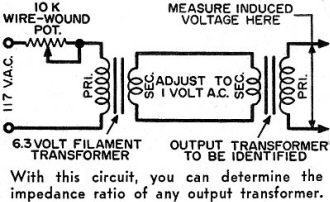Identifying Windings of Salvaged Transformers
|
|
Here is an interesting article that was probably much needed in its day (1956 Popular Electronics magazine) when many hobbyists were building and repairing their own electronic equipment. Being able to measure and identify unknown transformer winding parameters is key to both troubleshooting and determining whether a particular transformer is applicable for your need. Even professional repair shops often scavenged transformers from scrapped chassis for use in equipment brought in for service. The process can be extended to multiple winding transformers. Now you, too, can confidently tackle the unknown transformer and determine its construction. Identifying Salvaged Transformers
The equipment needed to identify a transformer consists of: an a.c. vacuum-tube voltmeter, such as the Heathkit Model AV-2; a small 6.3-volt filament transformer, such as the Triad F-13X (any 1-ampere unit will do as well); a 10,000-ohm wire-wound potentiometer; and a power cord and plug. Set up the circuit shown in the schematic diagram. If you are unable to tell by inspection which two of the four or five leads coming out of your transformer are the secondary connections, measure the d.c. resistances between the various leads. The two leads (of a 4- or 5-lead output transformer) that have the lowest resistance are the secondary leads. If you're checking a 4-lead transformer, the two remaining leads are the primary. If you're checking a 5-lead transformer, the two remaining leads that have the highest resistance are the two plate leads; the third lead is the center-tap connection. A 4-lead output transformer is made to match a single tube to a speaker voice coil. A 5-lead transformer matches push-pull tubes to the voice coil. After you have made the few simple connections, set the potentiometer to where the full 10,000 ohms is in the circuit, and plug the line cord into the 117-volt a.c. socket. Connect your v.t.v.m. across the secondary of the output transformer. Then, adjust the potentiometer until your meter reads exactly 1 volt. As soon as this adjustment has been made, set your meter to a higher range (the 100-volt range will usually be the right one), and immediately switch the meter leads to the primary of the output transformer. Measure the voltage across the primary and write it down. Multiply this number by itself, and then multiply the product by the voice-coil impedance of the speaker you want to use. Your final figure is the load impedance into which the plate of your power tube will work when you're using this particular transformer and speaker. Example I: Suppose, after setting the voltage across the secondary of our output transformer very carefully to 1 volt, we read the voltage across the primary and find it to be exactly 39.5 volts. We write this down and multiply it by itself (39.5 X 39.5) and obtain the product: 1560.25. The voice-coil impedance of the speaker we want to use happens to be 3.2 ohms, so we multiply our 1560.25 by 3.2, and get 4992.8. This is close to 5000, so we'll call it 5000 ohms - the right impedance to match the plate of a 6V6 or a 6AQ5 power tube. Example II: Suppose we have a 5-lead output transformer and, after carefully setting its secondary to 1 volt, we measure the voltage across the two primary plate leads and find it to be 42 volts. We have an 8-ohm speaker, so we multiply 42 X 42 X 8 and get 14,112. Call it 14,000 ohms. This will match a pair of 6F6's, or 6K6GT's, or 6AR5's in push-pull to the voice coil of our 8-ohm speaker. Proper plate loads at various grid bias and plate potentials for a number of power tubes can be found in the RCA Receiving Tube Manual, or the tube section of The Radio Amateur's Handbook published by the American Radio Relay League (A. R. R. L.). -Frank H. Tooker How It Works It is easy to identify the impedance ratio of an output transformer by means of two useful iron-core transformer formulas: (Ns/Np)2= Zs/Zp and Ns/Np = Es/Ep in which Ns represents the number of turns on the secondary of our output transformer; Np, the number of turns on the primary; Zs, the impedance to be placed across the secondary; Zp, the impedance reflected into the primary; Es, a voltage impressed or induced across the secondary; and Ep, the voltage impressed or induced across the primary. In this circuit. a filament transformer is used to drive the secondary of the unknown transformer. The voltage is carefully adjusted and measured by an a.c. vacuum-tube voltmeter. Once the secondary voltage is known, the v.t.v.m. is used to measure the voltage induced in the primary. Through the formula above, the nominal primary load impedance can be found.
Posted February 23, 2023 |
|

